In today’s digital age, creating a website has become easier. From bloggers to e-commerce store owners, websites have become a powerful tool to turn passions into profitable businesses. However, creating a website is just the beginning of the journey. To earn success, you need to monetize your website effectively.
Think of website monetization as your website’s side hustle, the cool gig allowing you to earn extra cash while doing what you love. Whether you’re a blogger, an ecommerce store owner, or a service provider, there are many ways to monetize a website and turn your passion into profit.
According to a recent study, the global website monetization market size is expected to reach $34.5 billion by 2026, with a CAGR of 16.3% from 2021 to 2026. Looking at these stats, are you wondering why your website is a money pit rather than a source of income? Well, it’s time to turn that frown upside down and monetize your website!
Strategies To Monetize Your Website
1. Start Affiliate Marketing
One method of making money from a blog is through affiliate marketing. Affiliate marketing is one of the most prevalent ways for bloggers to generate income. Affiliate marketing entails endorsing the wares of other companies. A commission is paid to you whenever one of your affiliate links results in a product sale. Let’s pretend your sales commission is $5. If 100 people use your affiliate link to purchase the product, you will earn $500. Joining an affiliate program like ShareASale, Amazon Associates, or Commission Junction is the simplest method to locate things to promote on your site.
To locate affiliate products to market, sign up with a network like this and browse their catalog. Fashion, food and drink, education, health, and many more fields have affiliate programs. Pick items that fit in with the subject matter of your site. You can increase the likelihood of selling by promoting products to your specific audience.
For instance, if your site is focused on health and fitness, you may promote items like workout clothes and gear.
EXAMPLE:
Expedia offers an affiliate program where bloggers and influencers can promote Expedia’s travel products on their websites and social media channels.

Bloggers who sign up for Expedia’s affiliate program receive a unique affiliate link to include in their blog posts, social media updates, or email newsletters. When someone clicks on the link and makes a purchase on Expedia’s website, the blogger earns a commission on the sale.
Expedia’s affiliate program has been successful because it aligns with the interests of its target audience: people who love to travel. Bloggers who join the program can promote Expedia’s travel products and earn money while providing valuable content to their readers.
By offering an affiliate program, Expedia has reached a wider audience and increased sales while building relationships with bloggers and influencers in the travel industry.
2. Advertise Your Blog with Google Adsense
When considering monetizing a blog, most people first think of advertising. Google Adsense is a simple method for monetizing a blog through advertising. Websites can display adverts through Google’s Adsense program. You generate revenue each time a site visitor clicks on one of your advertisements.
Your blog will display content- and readership-specific advertisements. For instance, ads on the travel site Adventurous Kate tend to be about traveling, and here’s one for those planning a honeymoon.
It’s also simple to integrate Google Adsense into your blog. Once the system is set up, the advertisements will appear automatically. Using MonsterInsights, you can monitor your Adsense earnings and see which advertisements generate the most clicks.
EXAMPLE:
A blogger named Pat Flynn runs the website Smart Passive Income, where he shares his experiences and strategies for building passive income streams. One of the ways he monetizes his blog is by using Google AdSense.
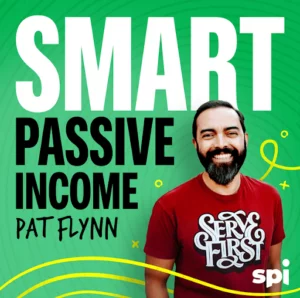
Pat’s blog receives significant traffic, and he uses Google AdSense to display relevant ads on his website. The ads target his audience, making them more likely to click on them. When someone clicks on an ad, Pat earns a commission from Google.
In addition to Google AdSense, Pat uses other monetization strategies such as affiliate marketing and selling digital products. However, Google AdSense has been a consistent source of income for his blog.
3. Sell Ad Space Directly
While Google Adsense can generate some income with minimal effort on your part, the potential payout is low. It would help if you considered making money from your site by selling direct advertising.
When you sell advertising space independently, you decide how much to charge. You can charge a set payment for a banner ad on your blog instead of getting paid a tiny amount for each click on an ad. A flat rate is more profitable than tracking clicks and simpler to administer.
Create an Advertise Here page or use a marketplace like BuySellAds to contact businesses interested in purchasing advertising space on your site. Direct ad sales are more work than Google Adsense since you have to handle everything from pricing negotiations to terms and agreements to billing.
But with the help of software like AdSanity, you can simplify the process significantly. AdSanity is an add-on for WordPress that streamlines ad administration. Putting adverts on your site, monitoring their performance, and more are all simple tasks.
EXAMPLE:
Kiersten Rich runs the travel blog The Blonde Abroad, where she shares her experiences and tips for traveling the world. Her blog receives over one million page views monthly, making it an attractive platform for advertisers.

Kiersten sells ad space on her blog to travel-related companies such as hotels, airlines, and tour operators. She offers different packages depending on the ad’s placement and the ad campaign’s duration. For example, a banner ad at the top of her website would cost more than a sidebar ad.
Kiersten also works with advertisers to create sponsored content, such as blog posts and social media updates. These sponsored posts are marked as such to comply with FTC regulations.
By selling ad space on her blog, Kiersten has been able to monetize her passion for travel and turn it into a profitable business. She’s built strong relationships with travel-related companies and has been able to provide valuable content to her readers while earning money from advertising.
4. Accept Sponsored Blog Posts
Need some extra cash? Try your hand at blogging for pay. If that’s the case, you should use paid advertising space. The use of advertisements in blog posts is widespread. A corporation will pay you to write blog posts promoting their products. They’ll even pen the piece; you only need to upload it. It’s analogous to how Instagram or YouTube stars get paid to promote a product they love.
Many businesses are willing to pay significant sums of money to have their products promoted on blogs with many regular readers, a steady publishing schedule, and high-quality content.
Joining such blogger networks can help you connect with firms that pay for possibilities.
EXAMPLE:
Aimee Song runs the fashion blog Song of Style, sharing her fashion and lifestyle tips with her readers. Her blog receives millions of page views monthly, making it an attractive platform for fashion and lifestyle brands.
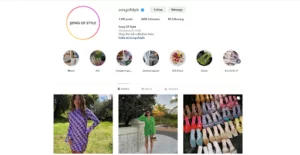
Aimee often accepts sponsored blog posts from brands relevant to her niche. These sponsored posts are marked as such and include a disclaimer to comply with FTC regulations. Aimee works closely with the brand to ensure that the post provides value to her readers and aligns with her brand.
For example, Aimee collaborated with the clothing brand Revolve on a sponsored blog post that featured Aimee wearing their clothing and sharing her favorite pieces from their collection. The post included high-quality photos and provided tips on how to style the clothing.
5. Get Paid for Writing Reviews
Accepting sponsored guest articles is analogous to being paid to write reviews. Paid reviews allow you to acquire free samples of products in exchange for writing reviews about them on your site.
You should only review goods that interest the people who read your site. If you run a site about personal finance, reviewing budgeting tools and apps would make more sense than reviewing household appliances like vacuum cleaners. Similar to sponsored content, paid reviews can be solicited from brands either directly or through a mediator service like PayPerPost.
EXAMPLE:
Kristyn Merkley runs the blog Lil’ Luna, where she shares her favorite recipes, crafts, and DIY projects. Her blog receives millions of page views monthly, making it an attractive brand platform.

Kristyn gets paid to write reviews of products relevant to her niche. These honest and detailed reviews provide her readers with valuable information about the products. Kristyn works closely with the brand to ensure that the review aligns with her brand and provides value to her readers.
For example, Kristyn collaborated with the kitchen appliance company Ninja on a review of their blender. The review included a detailed description of the blender’s features and performance and high-quality photos and videos of the blender in action. Kristyn also shared her favorite recipes that she made using the blender.
By writing product reviews and getting paid for them, Kristyn has been able to monetize her blog and turn it into a profitable business. She’s built strong relationships with brands and has been able to provide valuable content to her readers while earning money from product reviews.
6. Turn Your Blog Into a Membership Site
Because your content is so valuable to them, your most devoted readers will gladly pay to access additional pieces. Converting your blog into a membership site is similar to hiding your content behind a paywall; only paying members will have access. You can monetize your blog in two ways: by charging people a one-time price to access your content or by offering premium content for a monthly membership fee. As you can see, membership is a fantastic method to make money off a site. You may quickly and easily convert your blog into a membership site with the best plugins.
EXAMPLE:
The blogger behind Pinch of Yum, Lindsay Ostrom, offers a membership site called Food Blogger Pro. Food Blogger Pro is a community and education platform for food bloggers who want to grow their blogs and businesses.
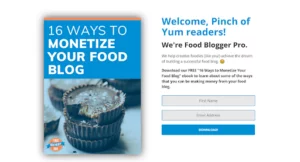
The membership site offers members exclusive content such as video courses, live Q&A sessions, and a private community forum. The courses cover photography, social media, and monetization strategies. Members can also access discounts on tools and services relevant to their niche.
Food Blogger Pro has been successful because it provides a valuable resource for food bloggers looking to grow their businesses. The community aspect of the membership site allows members to connect with like-minded individuals and share tips and strategies.
By offering a membership site, Lindsay has monetized her expertise and turned it into a profitable business. She’s built a loyal following of food bloggers who are willing to pay for access to exclusive content and resources.
7. Create a paid forum
Instead of turning your entire website into a membership site, you might create a secret forum that users would have to pay to access. Forums give your site’s users a central hub for in-depth conversations on a wide range of topics and direct, one-on-one response from you. This is a great way to encourage participation from existing readers and draw in new ones. In addition, you can charge users to access premium features on your site.
EXAMPLE:
John Lee Dumas, for instance, hosts the podcast Entrepreneur on Fire, in which he discusses business and shares the experiences of prominent entrepreneurs. His blog is read by millions of people every month, making it a valuable resource for budding business owners.

For those interested in expanding their enterprises, he hosts a closed discussion group. Members can get answers to questions, give and receive tips, and network with other business owners in this forum.
John not only provides a private forum, but also webinars, courses, and coaching services. John’s blog has become a thriving company because of the exclusive information he provides for his subscribers.
8. Write an Ebook
One of the most common ways bloggers make money is by selling electronic books (ebooks). Earning and keeping passive income typically takes very little time and effort. Writing an ebook requires you to do so only once, and you can then resell that ebook to your audience repeatedly.
But your ebook needs to be excellent to make money from it. More than anything else, your ebook’s topic must interest your intended readers. Sarah Mae, a blogger, published an ebook in response to a recurring question from her followers concerning forgiveness.
Transforming one of your most popular blog pieces into an ebook is another easy way to generate an ebook that your audience will appreciate.
If you’ve written a popular blog post about search engine optimization (SEO), consider expanding it into a comprehensive ebook.
EXAMPLE:
Amy Lynn Andrews runs the blog AmyLynnAndrews.com where she provides advice on blogging, online business, and personal development. Her blog receives thousands of page views monthly, making it an attractive platform for bloggers and entrepreneurs.
Amy has written several eBooks that are relevant to her niche, such as “Tell Your Time” and “The Useletter Guide to Email Marketing.” These eBooks are sold on her blog, and she has optimized her blog for eBook sales in several ways.
First, she uses strategic calls-to-action throughout her blog posts to promote her eBooks. She also has a dedicated “Books” page on her blog where visitors can see all her eBooks in one place. On this page, she includes detailed descriptions of each eBook and testimonials from satisfied customers.
In addition, Amy also uses email marketing to promote her eBooks. She has a dedicated email list for people interested in her eBooks, and she sends regular emails promoting her eBooks and offering discounts.
9. Sell Other Digital Products
Blogs may be used to sell a wide variety of digital things, including ebooks, templates, printables, WordPress themes, video tutorials, audio recordings like music or podcast episodes, and many more. You should sell your digital product if you worked hard to build something that people need and want.
EXAMPLE:
A good illustration of this is the blog ScrapGirls, which monetizes itself by selling scrapbooking designs and printables to the people who visit it. When it comes to digital scrapbooking, no one does it better than ScrapGirls. Angie Briggs and Ro Roehm, two friends who discovered a common interest in scrapbooking in 2004, launched the company. They embarked on this venture with the aim of developing user-friendly, low-cost options for digital scrapbooking.
The concept of creating digital scrapbooks didn’t exist until recently. Paper, stickers, and decorations are merely some of the actual items used in traditional scrapbooking. However, with the advent of digital scrapbooking, scrapbookers were able to make pages entirely from digital content, including photos, graphics, and text, all of which could be rearranged and edited digitally.
Providing an extensive selection of high-quality digital papers, decorations, and templates, ScrapGirls soon rose to prominence as a top provider of digital scrapbooking items. In addition, they introduced a series of online courses and tutorials aimed at teaching complete scrapbooking newbies how to make the most of their supplies.
10. Offer Online Courses
Offering online classes for a fee is a viable option if you have knowledge to share with your target market. In fact, being a “expert” is not even necessary to manage a prosperous online course. If you have a lot of knowledge in a given area, you may use your blog to make money by teaching others about what you know.
If you have a food blog, for instance, you might charge for online cooking lessons to monetise your audience. To create your virtual learning platform, use MemberPress. We’ve established that MemberPress is a great WordPress membership plugin; now let’s talk about the course management and sales features it offers.
EXAMPLE:
B-School by Marie Forleo is an illustration. B-School is an 8-week online program that instructs business owners on the finer points of advertising and promotion.

Marie Forleo started out as a fitness instructor before realizing that what truly fulfilled her was assisting others in realizing their own potential. To help others, she decided to launch a blog and called it MarieForleo.com. She saw a need to provide her growing community with more in-depth training and assistance, so she created B-School.
11. Host a Paid Webinar
You may advertise your information, display your expertise, and sell your wares by hosting a webinar. As a result, many bloggers and marketers employ this strategy.
A webinar is an online seminar or class that allows participants to ask questions and get answers in real-time. That being said, it’s a useful tool for engaging with viewers.
If you’ve already found a way to make money off your blog, you may use free webinars to spread the word about the goods and services you offer. If the content you plan to present is essential, consider selling registrations for a webinar.
Make a landing page just for your webinar to increase exposure and registrations. SeedProd, the best landing page builder plugin for WordPress, makes it simple to make one.
EXAMPLE:
Copyblogger is a popular website that provides content marketing education, resources, and services. They offer a range of free resources, including blog posts, podcasts, and e-books; they also monetize through their paid webinars.
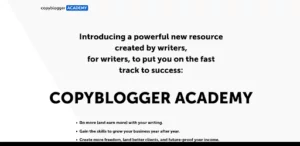
Copyblogger offers a series of paid webinars called the “Copywriting Masterclass Series.” Each webinar focuses on a specific aspect of copywriting, such as writing headlines or crafting persuasive email copy. The webinars are led by experienced copywriters and marketers and provide in-depth training and strategies for attendees.
Participants must pay a fee to attend the webinars, typically $97 to $197 per webinar. Copyblogger also offers a discount for attendees who purchase multiple webinars at once. The webinars are recorded and made available for purchase after the live event, providing additional revenue streams for Copyblogger.
12. Start Freelancing to Earn Money
Freelancing is a common way to make money online, and one way to promote yourself is through a blog. To start making money as a freelancer, you only need to advertise your services; there’s no need to invest anything in developing a physical good first.
Think you need something to offer your target market? Don’t think that!
You can offer your freelance writing skills to businesses since you are already a proficient writer due to your blogging experience. Many bloggers have made their first steps as independent authors.
Can you create compelling visuals? Freelance your skills as a graphic designer or infographic artist and target startups. Jobs in social media management, content promotion, accounting, website development, and many others are available on a freelance basis.
To locate freelance employment, you can use websites like Upwork. However, Upwork has a lot of competitors and deducts a fee from your paychecks.
Therefore, we suggest advertising your freelancing services on your website. To begin receiving customer inquiries, you must design a contact form for your website. Using WPForms, you can make one quickly. WPForms makes it easy to incorporate a feedback form into your site. In addition, the form can be used to receive payments and digital signatures from independent contractors.
You can also send cold emails or connect with potential clients on LinkedIn. This way, your internet business will be more distinctive, and you will have greater control over it.
13. Monetize with Merch
The merch table selling the band’s wares at most shows will be near the entrance. But did you know that selling swag is a viable means of making money off of a blog?
Many famous bloggers make money by selling branded merchandise, such as t-shirts, hats, and phone cases.
Your most devoted readers will proudly wear your swag to support your blog. While selling things can be challenging, these choices remove the need for you to handle inventory or shipping.
EXAMPLE:
Red Bull is an energy drink company that has expanded beyond beverages into a lifestyle brand. Their website has a wide range of merchandise, including clothing, accessories, and sporting equipment.
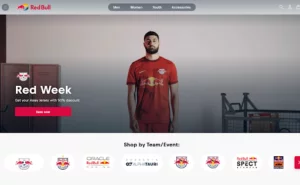
Red Bull’s merchandise often features its logo, but they also collaborate with athletes and artists to create unique and limited-edition designs. The merchandise not only serves as a way to promote the Red Bull brand but also generates significant revenue for the company.
14. Accept Donations
Sometimes, if your readers appreciate your work, they will gift you money without being asked. There is nothing dishonest about asking for money when giving away valuable and engaging stuff for free. Like many other websites, Wikipedia requires its users to make a monetary contribution.
Adding a PayPal donate button to your site will allow you to accept donations from your readers.
EXAMPLE:
Wikipedia is a well-known example of a website that relies on donations to support its operations. They are a non-profit organization that provides free access to knowledge and information to anyone with an internet connection. Wikipedia’s website does not feature any ads or paywalls, and they rely on donations from their users to cover their expenses.
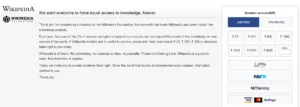
Wikipedia’s donation system is simple and effective. They ask for donations through a banner at the top of their website, and users can donate any amount they choose. Wikipedia also offers membership to those who donate a certain amount, which includes benefits such as access to special events and merchandise.
By relying on donations, Wikipedia can maintain its commitment to providing free and unbiased information to its users while still generating revenue to cover its operating expenses.
Conclusion
To successfully monetize your website, cater to the wants and needs of your target demography while also produce income in a way that is consistent with and true to your brand’s values. A long-lasting and lucrative website that improves the lives of its users can be made via ingenuity and careful planning. So go ahead and explore different ways to monetize your website and see how you can turn your website into a successful business or blog!
FAQs
What factors should I consider while deciding on how to monetize your website?
The best way to monetize your website will vary depending on your specific specialty, intended audience, and long-term objectives. Think about the things your target market cares about and is willing to spend money on. Finding out how competing sites in your field make money off of visitors’ attention is another option.
Can I use a combination of approaches to monetize my website?
You can employ many strategies to monetize your website at once; nevertheless, you need to strike a healthy balance between them. Advertising and sponsored content should be used sparingly to avoid diminishing the user experience.
How can I keep from overwhelming my readers with commercials and paid posts?
You should only advertise products or services that are relevant to your audience and provide value to them in your content to avoid bothering them with too many ads or sponsored content. Ads and sponsored material on a website should be kept to a minimum and should take the shape of non-intrusive ad formats.
Can I count on income from advertising to sustain my website?
Website monetization, if done properly, can be a steady stream of income, but it’s not a quick way to amass wealth. It takes time and work to create a thriving website and audience, and even then, your income is subject to fluctuations due to factors like traffic and advertiser demand.



